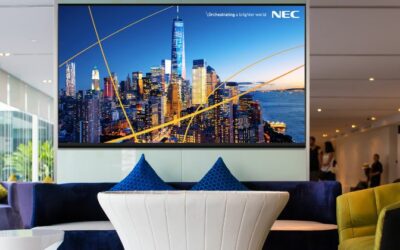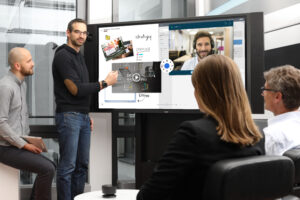
Introduction
Audio visual is everywhere. Whether you’re at home watching your favourite show on Netflix, in the workplace attending a corporate meeting, or in the cinema watching a movie, the applications of AV technology are increasingly prevalent nowadays. But have you wondered how audio and visual elements work on their own?
Read on to find out the components of AV system and how this technology is changing how we live and get entertained.
What is Audio Visual?
According to Merriam-Webster, audio visual refers to the combination of recorded images (visual) and sounds (audio) that get processed together instead of separately. It requires AV technology and equipment to process the two components for numerous applications, such as films, TV shows, theatre productions, web conferencing, live stream broadcasts, and AV presentations in schools and church services.
 Audio visual encompasses four essential components: video input, video output, audio input, and audio output. As mentioned, the technologies that aid in processing these components make it possible to have AV presentations, media, and communication production.
Audio visual encompasses four essential components: video input, video output, audio input, and audio output. As mentioned, the technologies that aid in processing these components make it possible to have AV presentations, media, and communication production.
To better understand what audio visual is, we need to look at the various technologies that have made it possible over the years. It also provides insight into the future of AV technology based on the trends throughout the years.
The Evolution of Audio Visual
The history of AV technology focuses on innovation. The developments and innovations in AV solutions have enabled modern society to enjoy communication and entertainment. All AV innovations and devices have allowed the industry to move forward and make way for better innovations in the future.
- 1888 – The use of celluloid film and adoption of the 35mm standard in photography.
- 1897 – The introduction of CRT displays.
- 1916 – The first condenser microphone was launched.
- 1923 and 1963 – The ribbon and shotgun microphones arrived, respectively.
- 1924 – The introduction of modern speakers.
- 1950 – The arrival of colour video cameras in television studios.
- 1950 – The development of acoustic technology for studio recording.
- 1970 – The arrival of camcorders and VHS formatting.
- 1972 – The arrival of yellow LED by George Craford.
- 1980 – The arrival of digital video cameras.
- 1990 – The introduction of high-definition digital recording.
- 2004 – Sony launched the first TV with LED backlighting.
- 2023 – LG launched the first OLED display TV.
The Applications of Audio Visual
Looking at real-world examples of AV usage provides an insight into how audio visual systems are highly integrated into this modern world. The following examples show the versatility of AV technology and how it’s advanced over the years.
Video Conferencing
 Advancements in AV equipment have made video conferencing possible. It is common in many corporate organisations nowadays, especially with the rapid globalisation of most companies with remote workers worldwide. Video conferencing requires audio visual systems and software to process audio and video elements for clearer communication.
Advancements in AV equipment have made video conferencing possible. It is common in many corporate organisations nowadays, especially with the rapid globalisation of most companies with remote workers worldwide. Video conferencing requires audio visual systems and software to process audio and video elements for clearer communication.
Corporate Events
AV equipment is essential for producing corporate events, such as conference room meetings, stakeholder’s meetings, round table discussions, conferences, and exhibitions. You can even use AV integrators for workshops and training of new and existing employees.
Church Services
Suitable AV systems make it possible for churches to host weekly services and reach out to their communities. Modern churches even have live worship streaming services across their various channels, enabling them to reach out to their communities and prospects most effectively.
Educational Presentations
There are various applications for audio visual technology in the education field. Audio visual presentations set the new standard for educational instruction since they are highly immersive and engaging. Integrating technology into the classroom is nothing new, but enhancing the use of technologies through AV devices makes teaching strategies more effective.
Communication
 Communication is one of the most fundamental areas where audio visual software and solutions are most useful. For example, corporate organisations employ audio visual tools to facilitate better and more effective corporate communication, especially during times of crisis. Other uses of AV in communications include presentation handouts, training tools and videos, and on-demand company video production.
Communication is one of the most fundamental areas where audio visual software and solutions are most useful. For example, corporate organisations employ audio visual tools to facilitate better and more effective corporate communication, especially during times of crisis. Other uses of AV in communications include presentation handouts, training tools and videos, and on-demand company video production.
Entertainment Production
Audio visual systems have many entertainment applications, such as film production, theatre shows, and TV streaming services. The prevalence of entertainment apps serves as the cornerstone of AV applications in the entertainment field.
Advertising
Audio visual technologies, such as LED displays, are a valuable asset in advertising. It offers many advantages over traditional advertising because it engages the audience and conveys advertising messages more efficiently. Audio and visual elements make it more persuasive, especially when targeted to the right audience.
Audio Visual Trends & Predictions
Diving into the complexities behind AV systems and technologies enables a deeper understanding of using such technology and AV equipment to make communication, AV production, and other applications possible.
AR/VR (Augmented Reality and Virtual Reality)
Augmented reality and virtual reality have been buzzwords in the AV industry for many decades. But now, they will have a stronger foothold in the various industries that utilise AV equipment for various presentations. AV/VR technology helps increase participation and engagement levels by providing a more interactive and immersive experience for the participants.
 AV and Cloud-Based Integrations
AV and Cloud-Based Integrations
The prevalence of cloud computing will have an impact on AV systems applications. The best example is in the modern workplace, wherein companies can collaborate via the cloud space, enabling access to virtual conferencing and meeting tools as if they are in the same room. The recent pandemic perfectly demonstrated the value of AV and cloud-based integrations in today’s modern working environment.
Spatial Audio
This audio visual trend for the future employs the combination of hardware and software to create a 360-degree sound stage. Therefore, this technology enables complete audio immersion for the participants during a presentation or production. When this technology was first introduced, it was targeted mainly for video games, but it is also valuable for communication, corporate events, and other presentations.
Cable-Less AV Connectivity
A cable-less future may be in the works for the audio visual industry. Standard analogue AV tech is headed toward becoming obsolete as AVoIP (Audio Visual over Internet Protocol) increases the scalability and flexibility of audio visual integrations. Since it is cost-effective and easy to install, adopting this technology makes the most sense.
Summary
 With all these new developments in the audio visual technology, there is an absolute promise that these trends will continue to evolve. Therefore, it is crucial to stay abreast of the latest innovations and audio visual equipment available to get a hold of them.
With all these new developments in the audio visual technology, there is an absolute promise that these trends will continue to evolve. Therefore, it is crucial to stay abreast of the latest innovations and audio visual equipment available to get a hold of them.
Whether you rely on AV equipment for corporate use, such as video conferencing and conference room meetings, or in other applications like education and church services, having access to the latest AV devices and tools can help achieve your objectives.
Mediascape is Scotland’s leading audio visual specialist, providing bespoke AV solutions for businesses of all sizes, across many industries. Contact us today and let us help you find the best solutions for all your AV requirements.
Related news
Benefits of Hybrid Classroom Technology
[pac_divi_table_of_contents title="Table of contents" allow_collapse_minimize="off" included_headings="off|on|on|on|on|off" active_link_highlight="on" level_markers_1="icons"...
Everything You Need to Know About Huddle Rooms in Your Workspace
[pac_divi_table_of_contents title="Table of contents" allow_collapse_minimize="off" included_headings="off|on|on|on|on|off" active_link_highlight="on" level_markers_1="icons"...
The Ultimate AV Equipment Checklist
[pac_divi_table_of_contents title="Table of contents" allow_collapse_minimize="off" included_headings="off|on|on|on|on|off" active_link_highlight="on" level_markers_1="icons"...


 AV and Cloud-Based Integrations
AV and Cloud-Based Integrations



